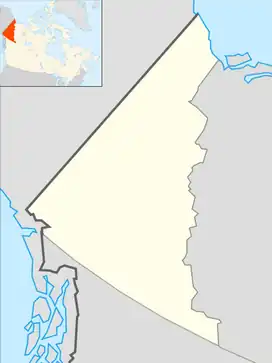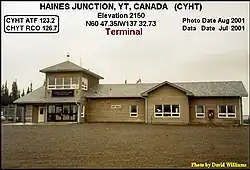Haines Junction, Yukon
Haines Junction is a village in Yukon, Canada. It is at Kilometre 1,632 (historical mile 1016) of the Alaska Highway at its junction with the Haines Highway, hence the name of the community. According to the 2021 Census, the population was 688.[2] However, the Yukon Bureau of Statistics lists the population count for 2022 as 1,018.[3]
Haines Junction | |
|---|---|
| Village of Haines Junction | |
 | |
 Haines Junction  Haines Junction | |
| Coordinates: 60°45′10″N 137°30′24″W | |
| Country | Canada |
| Territory | Yukon |
| Founded | 1942 |
| Incorporated | 1984 |
| Government | |
| • Village Mayor | Michael Riseborough |
| • Governing body | Village of Haines Junction Council |
| Area | |
| • Land | 34.49 km2 (13.32 sq mi) |
| Population (2016) | |
| • Total | 688 |
| • Density | 17.8/km2 (46/sq mi) |
| • Change 2016-2021 | |
| Time zone | UTC−07:00 (MST) |
| Postal code | |
| Area code | +1-867 |
| Climate | Dsc |
| Website | Official website |
Haines Junction lies east of Kluane National Park and Reserve. It is a major administrative centre for the Champagne and Aishihik First Nations.
History
For around two thousand years, the Southern Tutchone people had seasonal hunting and fishing camps in the area of present-day Haines Junction. The original name of the area was "Dakwakada", a Southern Tutchone word meaning "high cache". It was common for Tutchone people to use raised log caches to store food year-round or temporarily while they hunted and fished in an area.
The Haines Junction area was also important for trade between the coastal and interior peoples. It lies at the interior end of the Chilkat Pass, one of only three passes that allowed travel between the coast and the interior, which was used extensively for trade between the coastal Tlingit and Southern Tutchone people.
The current town of Haines Junction was established in 1942 and 1943 during the construction of the Alaska Highway (ALCAN). In 1943, a second highway, the Haines Highway, was built to connect the Alaska Highway with the coastal town of Haines, Alaska, over the Chilkat Pass. Situated at the junction of these two highways, Haines Junction was a construction camp and a supply and service centre for the U.S. Army Corps of Engineers building the highway. The 626-mile (1,007 km) Haines–Fairbanks petroleum pipeline was constructed in 1953–55, and a pumping station was built just north of Haines Junction.[4]
Geography
Climate
Haines Junction has a subarctic climate (Dfc) with mild summers and long, severely cold and snowy winters, with annual snowfall averaging 64.5 inches (164 cm).
| Climate data for Haines Junction | |||||||||||||
|---|---|---|---|---|---|---|---|---|---|---|---|---|---|
| Month | Jan | Feb | Mar | Apr | May | Jun | Jul | Aug | Sep | Oct | Nov | Dec | Year |
| Record high °C (°F) | 7.0 (44.6) |
13.0 (55.4) |
14.0 (57.2) |
21.0 (69.8) |
27.0 (80.6) |
33.0 (91.4) |
30.5 (86.9) |
31.0 (87.8) |
23.0 (73.4) |
22.0 (71.6) |
12.0 (53.6) |
14.5 (58.1) |
33.0 (91.4) |
| Average high °C (°F) | −15.3 (4.5) |
−8.1 (17.4) |
−0.1 (31.8) |
8.4 (47.1) |
— | — | 19.1 (66.4) |
17.1 (62.8) |
14.0 (57.2) |
4.8 (40.6) |
−8.3 (17.1) |
−10.9 (12.4) |
2.1 (35.8) |
| Daily mean °C (°F) | −20.6 (−5.1) |
−15.0 (5.0) |
−7.8 (18.0) |
0.9 (33.6) |
— | — | 12.5 (54.5) |
10.6 (51.1) |
7.2 (45.0) |
−1.0 (30.2) |
−13.2 (8.2) |
−15.9 (3.4) |
−4.2 (24.4) |
| Average low °C (°F) | −25.9 (−14.6) |
−21.1 (−6.0) |
−15.2 (4.6) |
−6.5 (20.3) |
— | — | 5.9 (42.6) |
4.0 (39.2) |
0.4 (32.7) |
−6.7 (19.9) |
−17.4 (0.7) |
−20.5 (−4.9) |
−10.3 (13.5) |
| Record low °C (°F) | −48.0 (−54.4) |
−47.5 (−53.5) |
−42.0 (−43.6) |
−32.0 (−25.6) |
−11.0 (12.2) |
−3.5 (25.7) |
−1.5 (29.3) |
−4.0 (24.8) |
−11.0 (12.2) |
−27.0 (−16.6) |
−42.0 (−43.6) |
−44.5 (−48.1) |
−48.0 (−54.4) |
| Average precipitation mm (inches) | 33.8 (1.33) |
24.5 (0.96) |
12.5 (0.49) |
7.9 (0.31) |
18.0 (0.71) |
35.3 (1.39) |
45.5 (1.79) |
37.7 (1.48) |
35.0 (1.38) |
26.7 (1.05) |
36.3 (1.43) |
40.1 (1.58) |
353.2 (13.91) |
| Average rainfall mm (inches) | 0.3 (0.01) |
0.5 (0.02) |
0.3 (0.01) |
2.2 (0.09) |
15.8 (0.62) |
35.3 (1.39) |
45.5 (1.79) |
37.7 (1.48) |
33.1 (1.30) |
11.2 (0.44) |
2.7 (0.11) |
4.9 (0.19) |
189.3 (7.45) |
| Average snowfall cm (inches) | 33.6 (13.2) |
24.0 (9.4) |
12.2 (4.8) |
5.7 (2.2) |
2.2 (0.9) |
0.0 (0.0) |
0.0 (0.0) |
0.0 (0.0) |
1.9 (0.7) |
15.5 (6.1) |
33.6 (13.2) |
35.3 (13.9) |
163.9 (64.5) |
| Average precipitation days (≥ 0.2 mm) | 8.4 | 5.6 | 3.5 | 2.7 | 5.5 | 7.8 | 8.4 | 8.5 | 8.7 | 7.0 | 8.4 | 8.3 | 82.7 |
| Average rainy days (≥ 0.2 mm) | 0.1 | 0.2 | 0.1 | 0.8 | 5.2 | 7.8 | 8.4 | 8.5 | 8.3 | 3.1 | 0.3 | 0.4 | 43.1 |
| Average snowy days (≥ 0.2 cm) | 8.4 | 5.4 | 3.5 | 2.0 | 0.4 | 0.0 | 0.0 | 0.0 | 0.5 | 3.8 | 8.2 | 8.0 | 40.2 |
| Source: Environment Canada Canadian Climate Normals 1981–2010[5] | |||||||||||||
Demographics
In the 2021 Census of Population conducted by Statistics Canada, Haines Junction had a population of 688 living in 311 of its 380 total private dwellings, a change of 12.2% from its 2016 population of 613. With a land area of 34.3 km2 (13.2 sq mi), it had a population density of 20.1/km2 (52.0/sq mi) in 2021.[16]
Infrastructure

By road, Haines Junction is served by the Alaska Highway and the Haines Highway (Yukon Highway 3). By air, it is served by the Haines Junction Airport.
Fibre connections to most homes and businesses are becoming available in late 2022/early 2023. Bell Mobility operates a cellular network tower in the area.
See also
References
- Your Elected Officials
- Population and dwelling counts Statistics Canada
- http://www.arlis.org/docs/vol1/AlaskaGas/Report4/Report_CEMML_2003_HainesFairbanksPipeline.pdf
- "Haines Junction YTG" (CSV (2874 KB)). Canadian Climate Normals 1981–2010. Environment Canada. Climate ID: 2100631. Retrieved 2014-02-20.
- "Table 2: Population of Census Subdivisions, 1921–1971". 1971 Census of Canada (PDF). Population. Vol. Census Subdivisions (Historical). Ottawa: Statistics Canada. July 1973. Retrieved January 30, 2022.
- "1976 Census of Canada: Population - Geographic Distributions" (PDF). Statistics Canada. June 1977. Retrieved January 30, 2022.
- "1981 Census of Canada: Census subdivisions in decreasing population order" (PDF). Statistics Canada. May 1992. Retrieved January 30, 2021.
- "1986 Census: Population - Census Divisions and Census Subdivisions" (PDF). Statistics Canada. September 1987. Retrieved January 30, 2022.
- "91 Census: Census Divisions and Census Subdivisions - Population and Dwelling Counts" (PDF). Statistics Canada. April 1992. Retrieved January 30, 2022.
- "96 Census: A National Overview - Population and Dwelling Counts" (PDF). Statistics Canada. April 1997. Retrieved January 30, 2022.
- "Population and Dwelling Counts, for Canada, Provinces and Territories, and Census Subdivisions (Municipalities), 2001 and 1996 Censuses - 100% Data (Yukon Territory)". Statistics Canada. August 15, 2012. Retrieved January 30, 2022.
- "Population and dwelling counts, for Canada, provinces and territories, and census subdivisions (municipalities), 2006 and 2001 censuses - 100% data (Yukon Territory)". Statistics Canada. August 20, 2021. Retrieved January 30, 2022.
- "Population and dwelling counts, for Canada, provinces and territories, and census subdivisions (municipalities), 2011 and 2006 censuses (Yukon)". Statistics Canada. July 25, 2021. Retrieved January 30, 2022.
- "Population and dwelling counts, for Canada, provinces and territories, and census subdivisions (municipalities), 2016 and 2011 censuses – 100% data (Yukon)". Statistics Canada. February 8, 2017. Retrieved January 30, 2022.
- "Population and dwelling counts: Canada, provinces and territories, and census subdivisions (municipalities), Yukon". Statistics Canada. February 9, 2022. Retrieved February 18, 2022.
External links
- Official website
 Haines Junction travel guide from Wikivoyage
Haines Junction travel guide from Wikivoyage